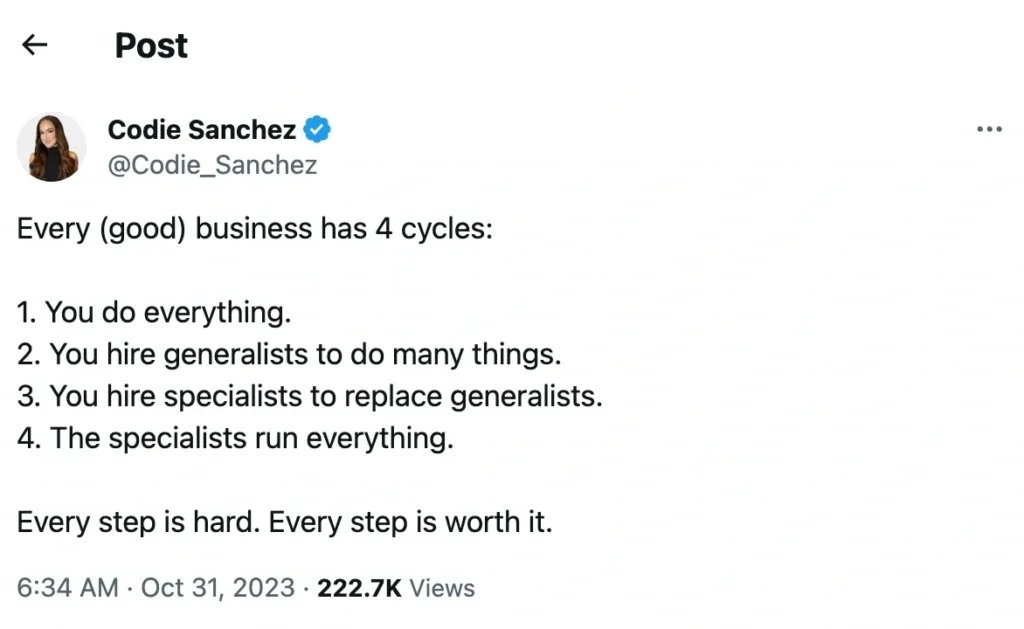
In my work with a critical client, a pivotal realization dawned on us at the outset of this year. We faced a daunting challenge: a projected revenue dip of about 10%. Our response? We didn’t just brace for impact; we strategized. We tailored a plan addressing our pain points and established revenue and profit goals—a practice not diligently pursued in the past. But the real game-changer was integrating the MAP system into our company fabric. This tool sharpened our focus, aligning our daily grind with our objectives. The result? Not just met goals, but growth—a testament to the power of strategic planning.
The journey underscored a fundamental truth: strategic planning isn’t a luxury; it’s a necessity, significantly when scaling a business. It’s akin to setting sail with a compass; without it, you’re at the mercy of the business seas—directionless.
Spotting the Opportunity: Strategic Market Analysis
When we first canvassed the market landscape, it was like peering into a crowded room, spotting faces that seemed perfect for our services. But, upon closer strategic analysis, we discerned that not just any company would benefit from our expertise. We needed specificity. It was a revelation of quality over quantity. We honed in on a subset of businesses where our impact could be magnified. This wasn’t about servicing everyone but excelling with those we could best serve.
This sharpened focus is at the heart of strategic market analysis. It’s about cutting through the noise to find your symphony, the sweet spot where your services resonate the most. For GB3 | CO, it’s not just about finding clients; it’s about finding the right clients. That’s the cornerstone of sustainable business growth.
Goals That Grow With You: Setting Scalable Objectives
The transformation is palpable when I introduce the concept of SMART goals to my clients. Initially, their objectives are often nebulous—lacking specificity and a timeline. The SMART framework—Specific, Measurable, Achievable, Relevant, and Time-bound—immediately focuses on their aspirations. But it’s not just about setting these goals; it’s the subsequent epiphany of accountability. It’s not easy, but with guidance, we sculpt their ambitions into measurable milestones.
Through the consistent application of SMART goals, my clients have crafted a roadmap for success that is both clear and actionable. These goals serve as leading indicators, paving the way for a robust system of regular reviews and adjustments. This discipline around goal setting and monitoring is the linchpin of strategic business growth—transforming aspirations into actualities.
A client’s business journey from a comfortable plateau to a steep growth curve exemplifies the essence of scalability. They had a thriving business with a somewhat informal model sustained by a tight-knit team’s loyalty and the founder’s vision. However, the model’s limitations became apparent when they sought to scale. The existing team’s loyalty was unmatched, but it set a bar too high for new hires who lacked the same historical commitment.
The solution was a deliberate recalibration of their business model, establishing clear expectations, delineating responsibilities, and setting precise goals. This new structure didn’t just accommodate new staff—it sharpened everyone’s focus. It was about crafting a machine where every gear, old or new, meshed seamlessly to drive the company forward. This wasn’t just change but evolution—a metamorphosis catalyzed by strategic planning that allowed the company to scale, adapt, and thrive.
Efficiency at Scale: Streamlining Operations
In the grand tapestry of business growth, operational efficiency is the thread that binds success. Codie Sanchez’s profound observation of the stages of business—from a singular owner-operator to a team of specialists—mirrors my experiences with clients.

The actual efficiency begins in phase three, where specialists take the helm in their respective arenas, allowing for a level of focus and expertise that generalists can rarely match.
It is here, in this phase, where each individual’s priorities crystallize. The fog of multitasking clears, and the clarity of dedicated roles emerges. My clients have witnessed their operations transform from a catch-all flurry of tasks to a well-oiled machine where each part functions purposefully and precisely. This transition to specialist-driven processes is not just an upgrade; it’s a revolution in how work is done and pivotal for any business poised for growth.
Funding Your Future: Financial Strategies for Scaling
The financial dimension of scaling is akin to preparing for a high-altitude climb; you must adequately equip yourself before ascending. Early on, businesses might operate with lean margins, perhaps undercharging to gain traction. This is sustainable only until a certain point. The actual financial strategy begins when you align your pricing with the value delivered, ensuring your business isn’t just surviving but thriving.
In the businesses I’ve counseled, the most impactful strategy has been to hire individuals not solely based on their current skill set but on their cultural fit and potential to grow. It’s a nuanced approach to compensation that seeks the best person for the role at the most reasonable cost—not necessarily the cheapest, but the most value-aligned.
Moreover, I advise securing the most extensive line of credit feasible before scaling begins. It’s about having that financial safety net in place—not to encourage debt but to ensure liquidity when the growth trajectory accelerates. Preparedness in financial planning is not just about having funds; it’s about having the proper funds available at the right time.
Assembling Your A-Team: Scalability in Human Resources
The alchemy of constructing a team that adapts and thrives with the business lies in the core values — those few but mighty tenets that are the heartbeat of a company’s culture. In my consultancy practice, I’ve observed that the most cohesive teams are built on a foundation where these values are not just stated but are deeply believed in and practiced.
It starts with identifying genuine core values that go beyond aspirational ideals — ones that, if breached, have real consequences. They form the litmus test for every hire and the framework for every team interaction. By anchoring the recruitment and development process around these core values, we ensure that each team member is fit for the job and the culture.
This emphasis on core values has helped companies I’ve worked with to foster an environment where like-minded individuals pursue a shared purpose. It’s not about finding people who can do the job; it’s about finding people who resonate with the heart of the business, thus building your A-Team for growth.
The Growth Tightrope: Managing Scaling Challenges
Scaling a business is akin to navigating a tightrope; it requires balance, focus, and a safety net. The most common challenge that almost every business faces on this journey is financial — there’s a perennial need for capital to fuel growth. It’s a complex dance of timing, investment, and resource allocation, with money as the pivotal partner.
In my role, I’ve seen companies grapple with this challenge by building robust financial reserves, pursuing strategic debt, or considering equity sales — each a viable strategy, yet each has its implications. A large treasury provides a buffer, debt can offer leverage, and selling equity might bring funds and new expertise to the table.
The key is to have these financial mechanisms in place before the scaling need becomes acute. It’s about preemptive action — securing a line of credit when the waters are calm, not when the storm hits. This proactive approach gives a business the agility to navigate the financial tightrope of scaling confidently.
Measuring Milestones: KPIs and Success Metrics
In expansion, navigating without key performance indicators (KPIs) is like sailing without a compass — possible but difficult. The Customer Acquisition Cost (CAC) stands out as a beacon, guiding decisions on where and how to allocate marketing dollars. It’s a delicate balance between the cost to acquire a customer and the revenue they bring, a metric that can mean the difference between profitable growth and costly expansion.
The Gross Profit (GP) metric is equally critical, illuminating the business’s health beyond top-line revenue. When scaling, it’s a reality check, as it reflects the true profitability after the costs of delivering your services or products.
Service salary to service revenue ratio, Accounts Receivable, sales activities, and customer onboarding timeframes are other vital signposts. Together, they form a dashboard that provides real-time insight into the business’s heart, keeping the pulse on efficiency and effectiveness. By focusing on these KPIs, businesses can ensure their growth trajectory is ambitious, sustainable, and well-managed.
Case Studies: Learning from the Leaders
The previously mentioned client’s story is one of disciplined growth and the power of strategic planning. Like many companies on the brink of expansion, they had previously planned sporadically, often leaving them reacting to growth rather than directing it. Our intervention set a new cadence for strategic sessions, embedding them firmly into the company’s routine with scheduled planning and regular follow-ups.
We instituted weekly meetings to keep a steady hand on the company’s pulse and monthly gatherings to ensure accountability to our strategic goals. This rigor turned strategic planning from a neglected task to the company’s growth engine. The results were transformative: a team more aligned, goals more consistently met, and a company culture invigorated by a clear vision of the future. It exemplifies the profound impact of deliberate, consistent planning on a business’s trajectory.
Actionable questions for the reader:
- Assess Your Strategic Position: Have you identified your business’s unique value proposition, and how does it align with the specific needs of your target market?
- SMART Goal Setting: Reflect on your current business goals. Can you redefine them using the SMART criteria to enhance clarity and measurability?
- Innovate to Scale: When did you last evaluate your business model for scalability? What steps can you take to refine it for growth?
- Financial Readiness: How prepared is your business financially to scale up? Do you have a strategy to secure the necessary funds without jeopardizing your company’s values or control?
- Cultural Cohesion: Are your company’s core values clearly defined and actively lived out? How can these principles guide you in building a team that grows with your business?
Further Reading Recommendations
- “Good to Great: Why Some Companies Make the Leap… and Others Don’t” by Jim Collins — This book dives deep into how companies transition from being good to great and how most companies fail to make the transition.
- “Scaling Up: How a Few Companies Make It… and Why the Rest Don’t” by Verne Harnish — Harnish offers practical tools and techniques for building an industry-dominating business.
- “The Lean Startup: How Today’s Entrepreneurs Use Continuous Innovation to Create Radically Successful Businesses” by Eric Ries—Ries’s book is a new approach adopted across the globe, changing how companies are built and new products are launched.
Written by Gary Boyle, founder at GB3 | CO. Gary is a seasoned entrepreneur and business strategist with years of experience guiding startups and established businesses to success. He specializes in helping business leaders make insightful decisions through strategic planning.
If you found this article insightful and want to stay updated with more content to help you transform your business, consider subscribing to our newsletter. For tailored business consultations, contact us at GB3 | CO. Let’s innovate and grow together.






